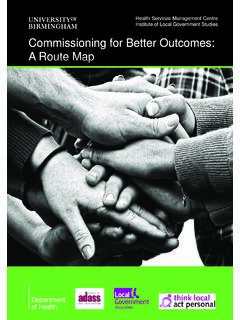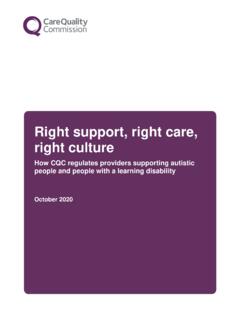Transcription of NEEDS ASSESSMENT HANDBOOK
1 NEEDS . ASSESSMENT . HANDBOOK . CONTENTS. Foreword: UNHCR's strategic Approach to NEEDS Assessments 4. Acknowledgement 7. Purpose 8. Scope 8. PART 1: NEEDS ASSESSMENT In UNHCR Operations 11. NEEDS ASSESSMENT Overview 11. Definition and Purpose of NEEDS Assessments 11. Coordination Modalities for NEEDS Assessments 13. Types of NEEDS Assessments 15. When to Conduct a NEEDS ASSESSMENT 17. ASSESSMENT Strategy 20. Preparedness 20. Roles and Responsibilities for NEEDS Assessments 21. Operations Management Cycle: All UNHCR Operations 21. Refugee Situation: UNHCR-led Response 22. IDP and Non-refugee Situations 24. Mixed Situations 25. Resourcing Assessments 26. Principles in Conducting NEEDS Assessments 29. Key Principles for NEEDS ASSESSMENT 29. Rights-Based Approach 31. Participatory Approach, Community Engagement, and Accountability 31.
2 Protection-centred Approach 33. Link to Other Processes and Information Systems 34. Population Data Management and NEEDS ASSESSMENT 34. Registration of Refugees and Asylum-seekers in proGres 35. IDP Enrolment for Assistance 36. Profiling Displacement Situations 37. Targeting 38. Protection Information Management Systems 39. The NEEDS ASSESSMENT Process 41. Step 1: Understand Context 41. Step 2: Plan the NEEDS ASSESSMENT 42. Step 3: Collate and Collect Data 43. Step 4: Draw Conclusions: NEEDS Analysis 44. Step 5: Share Information 45. Additional Resources & Guidance 46. > PART 1 3. Foreword: UNHCR's strategic Approach to NEEDS Assessments We require NEEDS assessments that are impartial, unbiased, comprehensive, context-sensitive, timely and up-to-date. NEEDS assessments must provide a sound evidence base for humanitarian response plans and prioritised appeals with due regard for specific accountabilities of mandated agencies [ ] The NEEDS ASSESSMENT process must be coordinated, impartial, collaborative and fully transparent with a clear distinction between the analysis of data and the subsequent priori- tisation and decision-making.
3 ' The Grand Bargain, World Humanitarian Summit (Turkey, 23 May 2016) 1. As a result of the World Humanitarian Summit in 2016, the Grand Bargain established 10. commitments for aid organizations and donors to work together efficiently, transparently, and harmoniously in order to better deliver protection and assistance to the millions of people facing emergency NEEDS . One of these commitments calls for the improvement of NEEDS assessments, notably by: 1. Providing a single, comprehensive, cross-sectoral, methodologically sound, and impartial overall ASSESSMENT of NEEDS for each crisis to inform strategic decisions;. 2. Coordinating and streamlining data collection to ensure compatibility, quality and comparability, and avoid over- ASSESSMENT and duplication;. 3. Sharing NEEDS ASSESSMENT data in a timely manner, with the appropriate mitiga- tion of protection and privacy risks; and 4.
4 Prioritizing humanitarian response across sectors based on evidence established by the Given that UNHCR is one of the signatories of the Grand Bargain, the agency's NEEDS ASSESSMENT HANDBOOK and its accompanying online NEEDS ASSESSMENT Toolkit provide guidance on how to accomplish these objectives. UNHCR operations have been conducting collaborative, protection-sensitive NEEDS assessments for years. However, the rigour demanded by donors and formalized by 1 The Grand Bargain: A Shared Commitment to Better Serve People in Need, Istanbul (Turkey), 23 May 2016. 2 With regard to NEEDS assessments (Commitment 5), the Grand Bargain also stipulates that the signatories must dedicate resources and involve independent specialists within the clusters to strengthen data collection and analysis in a fully transparent, collaborative process'; commission independent reviews and evaluations of the quality of NEEDS ASSESSMENT findings and their use'; and, conduct risk and vulnerability analysis with development partners and local authorities'.
5 Moreover, under Commitment 4 to Reduce duplication and management costs with periodic functional review', there is a commitment to reduce the costs and measure the gained efficiencies of delivering assistance with technology (including green) and innovation', for example by expanding the use of mobile technology for NEEDS assessments/post-distribution monitoring'. These commitments will be dealt with through other UNHCR initiatives. 4 UNHCR > NEEDS ASSESSMENT HANDBOOK . the cluster system to adequately address the NEEDS and priorities of populations of concern now requires UNHCR to engage in more formal, methodologically sound, and transparent processes for joint assessments and joint analysis. Joint and harmonized assessments lead to efficiencies, prevent the over- ASSESSMENT of populations of concern, and help establish a common inter-agency understanding of a situation at the outset of a crisis and throughout the programme management cycle.
6 Recognizing the importance of maintaining the link between NEEDS assessments and monitoring, regular joint NEEDS analysis provides an evidence base for medium- and long-term planning, including multi-year protection and solutions strategies. Similarly, to bridge the humanitarian and development gap, links are being strengthened with de- velopment frameworks and assessments such as UNDAF, Recovery and Peace-building Assessments (RPBA), and socio-economic research by actors such as the World Bank. This HANDBOOK represents the first guidance UNHCR has produced on NEEDS assess- ment that applies to all sectors, situations, methods, and populations of concern. Al- though the HANDBOOK should not be considered policy, it serves the similar purpose of committing the Office and its staff members to a set of global principles, objectives, standards, procedures, and working methods.
7 As the culmination of years of research and broad consultations, it consolidates practices, standards, and guidance from across UNHCR and operationalizes the IASC Operational Guidance on Coordinated Assessments in Humanitarian Crises. With this HANDBOOK , UNHCR seeks to build on its strengths and core mandate to ensure that the centrality of protection is mainstreamed in all NEEDS assessments. For a human- itarian response to be protection-oriented, it is essential to understand and seek to pre- vent, mitigate, and/or end actual and potential risks. This requires a continuous analysis of the NEEDS , risks, threats, vulnerabilities, and capacities of affected persons on the one hand, and of the commitment and capacities of duty bearers to address risk factors on the other. Such an analysis provides the evidence base for programming, advocacy, and other activities that aim to change behaviours and policies in support of a more favourable protection environment and better protection NEEDS ASSESSMENT activities are characterized as any exercise conducted to under- stand the various NEEDS of a population.
8 In practice there are different ASSESSMENT tools and methods that can be used. It is good practice to establish a comprehensive assess- ment strategy that employs various ASSESSMENT tools to meet the NEEDS of each sector, based on the level and types of operational data required to achieve the identified pur- pose. See Annex 7 for more details on common assessments terms and 3 IASC, Policy on Protection in Humanitarian Action, 2016. 4 Note that there is sometimes confusion between NEEDS assessments, the UNHCR Tool for Participatory Assessments, and participatory approaches. All NEEDS assessments must adhere to the principles and practices of participatory approaches. While the scope and activities of participation may depend on the specific context of each situation, participatory and community-based approaches are the way UNHCR does business.
9 ' NEEDS ASSESSMENT activities, on the other hand, are characterized as an exercise conducted at a single point in time to understand the various NEEDS of a population. In practice there are many different ASSESSMENT approaches and tools that can be used to undertake NEEDS assessments, including highly qualitative approaches such as the UNHCR Tool for Participatory Assessments and/or a more quantitative ASSESSMENT approach such as IDP profiling ( a household level, representative survey). Both methods are types of assessments within the broader protection information management category of NEEDS Assessments, but they employ different data collection techniques, which alter how operations can use the resulting data. > PART 1 5. Regardless of the type of ASSESSMENT chosen, participatory approaches must apply and guide all aspects of ASSESSMENT activities.
10 While the scope of participation may depend on the specific context of each situation, continuous participatory approaches are stan- dard UNHCR practice. The HANDBOOK is structured in two parts. The first, which is recommended for all au- diences, defines need assessments and their different types; describes coordination modalities; outlines the roles and responsibilities of different actors in refugee situations, IDP situations, and mixed situations; provides an overview of the steps to conduct NEEDS assessments and the principles that should guide them; and explains the relationship between NEEDS assessments and other information systems. The second part of the HANDBOOK provides detailed practical guidance on how to conduct NEEDS assessments in the field. It can be used as a reference text, with readers referring to specific steps and sections as needed based on their role in the operation or the NEEDS ASSESSMENT , and the type of situation.


